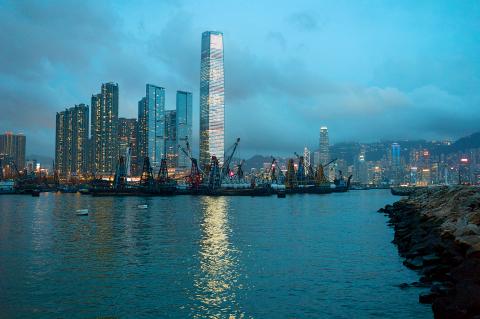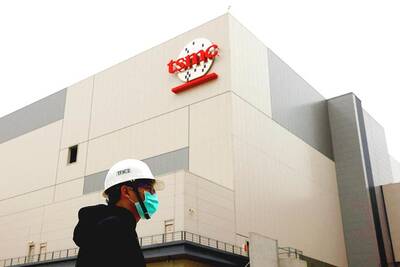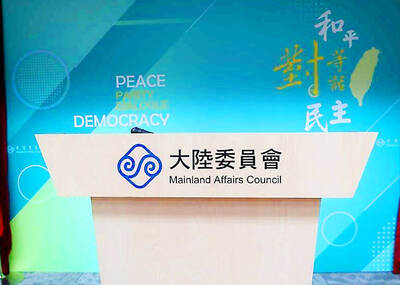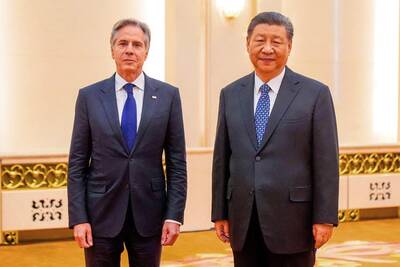Hong Kong police have launched a crackdown on political banners and images ahead of a visit to the territory by Chinese President Xi Jinping (習近平) to avoid “embarrassing” the country’s leaders.
Swaths of Hong Kong are to be locked down this week and at least 9,000 police officers, nearly a third of the territory’s force, are set to be deployed during Xi’s three-day visit starting on Thursday.
Police have been instructed to remove signs calling for remembrance of the victims of the 1989 Tiananmen Square Massacre or advocating direct elections of the territory’s leader, according to local media reports.

Photo: EPA
The aim of restricting the public’s right to freedom of expression is to “prevent leaders from being embarrassed” and signs must not appear on Xi’s routes through the territory.
The tactic is more often associated with mainland China, where there is little tolerance of dissent, than Hong Kong.
A police source confirmed the directive, adding that frontline officers were under immense pressure to ensure Xi’s visit went smoothly and that the protesters were kept away.
Images of Xi holding a yellow umbrella, a symbol of the 2014 pro-democracy protests, are also to be removed by police.
Xi is to visit Hong Kong to mark the 20th anniversary of the UK handing the territory back to China and to swear in the chief executive-elect.
Since the handover in 1997, July 1 is typically marked by large protests and opposition parties have vowed to come out in force this year.
Joshua Wong (黃之鋒), a prominent pro-democracy campaigner, has called for “demonstration instead of celebration” to mark Xi’s visit.
However, campaigners have complained Hong Kong authorities are attempting to curtail their ability to protest, with officials denying protesters use of the typical rallying point of Victoria Park to begin their march to the territory’s financial district.
Hong Kong police did not respond to requests for comment.

Taiwan Semiconductor Manufacturing Co (TSMC, 台積電) on Wednesday said that a new chip manufacturing technology called “A16” is to enter production in the second half of 2026, setting up a showdown with longtime rival Intel over who can make the fastest chips. TSMC, the world’s biggest contract manufacturer of advanced computing chips and a key supplier to Nvidia and Apple, announced the news at a conference in Santa Clara, California, where TSMC executives said that makers of artificial intelligence (AI) chips will likely be the first adopters of the technology rather than a smartphone maker. Analysts said that the technologies announced on

NO RECIPROCITY: Taipei has called for cross-strait group travel to resume fully, but Beijing is only allowing people from its Fujian Province to travel to Matsu, the MAC said The Mainland Affairs Council (MAC) yesterday criticized an announcement by the Chinese Ministry of Culture and Tourism that it would lift a travel ban to Taiwan only for residents of China’s Fujian Province, saying that the policy does not meet the principles of reciprocity and openness. Chinese Deputy Minister of Culture and Tourism Rao Quan (饒權) yesterday morning told a delegation of Chinese Nationalist Party (KMT) lawmakers in a meeting in Beijing that the ministry would first allow Fujian residents to visit Lienchiang County (Matsu), adding that they would be able to travel to Taiwan proper directly once express ferry

CALL FOR DIALOGUE: The president-elect urged Beijing to engage with Taiwan’s ‘democratically elected and legitimate government’ to promote peace President-elect William Lai (賴清德) yesterday named the new heads of security and cross-strait affairs to take office after his inauguration on May 20, including National Security Council (NSC) Secretary-General Wellington Koo (顧立雄) to be the new defense minister and former Taichung mayor Lin Chia-lung (林佳龍) as minister of foreign affairs. While Koo is to head the Ministry of National Defense and presidential aide Lin is to take over as minister of foreign affairs, Tsai Ming-yen (蔡明彥) would be retained as the nation’s intelligence chief, continuing to serve as director-general of the National Security Bureau, Lai told a news conference in Taipei. Koo,

MANAGING DIFFERENCES: In a meeting days after the US president signed a massive foreign aid bill, Antony Blinken raised concerns with the Chinese president about Taiwan US Secretary of State Antony Blinken yesterday met with Chinese President Xi Jinping (習近平) and senior Chinese officials, stressing the importance of “responsibly managing” the differences between the US and China as the two sides butt heads over a number of contentious bilateral, regional and global issues, including Taiwan and the South China Sea. Talks between the two sides have increased over the past few months, even as differences have grown. Blinken said he raised concerns with Xi about Taiwan and the South China Sea, along with China’s support for Russia and its invasion of Ukraine, as well as other issues